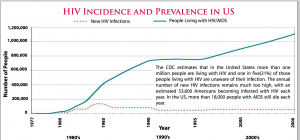Why Effective Treatment Can Make a Disease MORE Common
Listen my dears and you will learn the difference between incidence and prevalence and why effective treatment for a disease may mean that more people have it.
Prevalence is the number of people in the population who have a disease. It is computed as
Number of people with disease X 1,000
Number in population
As I mentioned before, there is nothing magical about 1,000 and you could compute prevalence per 100, per 100,000 or per million.
The important point is that prevalence is the number who HAVE the disease.
Below, you see a graph of prevalence and incidence of HIV in the U.S. from 1997- 2006.
The green line is prevalence, the number who have the disease. Clearly, prevalence went up after 1995.
So, did the AIDS epidemic get worse? No, actually, it stayed the same in one sense and got better in another.
The red dotted line is incidence. If you define epidemic, as occurrence of a disease in excess of normal frequency, then there has been no change and no evidence of a worsening epidemic, even though more people HAVE the disease. How can that be?
INCIDENCE is the number of new cases occurring, you compute it like this
Number of new cases during a period of time x 1,000
Number in population at risk during period
Prevalence is affected by both incidence and duration. If a lot of people get the disease but the duration is short the prevalence won’t be as high as it would be if the duration was very long. That’s one reason you’ll find the prevalence of diabetes is higher than, say, chicken pox. Even though a lot of people get chicken pox, it doesn’t last very long. In contrast, once you have diabetes, you have it for years.
Another reason duration could be low is that mortality is high. If people die of a disease at a high rate, within a short period of time, prevalence would be low, but this would generally not be considered a good thing. Once effective treatment is found and people live longer, the prevalence would go UP, which is exactly what happened with HIV. In 1997, there was a 40% decline in AIDS deaths as a result of new, effective, anti-retroviral drugs. That lower death rate has been maintained so year after year the number of people who have HIV has increased even though the incidence has been pretty stable.
Diabetes is another example of a disease that has been affected by effective treatment. A friend of mine told me this story:
An elderly patient was against taking the medication he had been prescribed for his diabetes and high blood pressure. He demanded of his physician.
They didn’t have all of this medication back in the old days. What did they do then, huh?
To which Jake politely replied,
Well, sir, they died.
However, effective treatment is only one reason that diabetes prevalence is rising in modern times. Remember prevalence is affected both by incidence and duration. Well, the incidence of diabetes has been increasing dramatically.
Since it is nearly 3 am in North Dakota though, and I am flying home today, that will have to be a post for another day.

While an increasing prevalence indicates that we have gotten better at keeping patients alive, it also shows they aren’t getting cured. More cures would also cause prevalence to drop, too.
Medical success is now measured in terms of “living longer with the disease” – we’ve gotten really good at keeping people alive, managing symptoms, but “effective treatment” should involve actually curing people.
Modern medicine is better than ever at keeping people alive, but when it comes to complete cures, many avenues of research are being neglected or even actively suppressed in favor of the symptom-relief model: “take these pills and come back next week.” instead of “ok, now let’s see, how much exercise do you do? What’s your diet like?… What do you mean you never eat veggies?”.
Speaking as someone who was supposed to die a few years ago from a chronic “incurable” disease that was cured over a couple months with vitamins, food, rest and exercise, I’d say that if a disease’s prevalence increase, it ain’t good.
It should drop on account of people getting cured, not shoot up because we can keep them alive and sick.
Hope this doesn’t come across as too harsh. I have a lot of respect for you, but I am tired of hearing that “effective treatment” consists of “managing disease”. Whatever happened to the idea that medicine was supposed to cure patient so they actually get well?
Doesn’t come across as too harsh at all and I agree with you. My point was simply a statistical one, this is how it CAN happen. I’ll get to your point later about the difference between treatment and cure, in another post